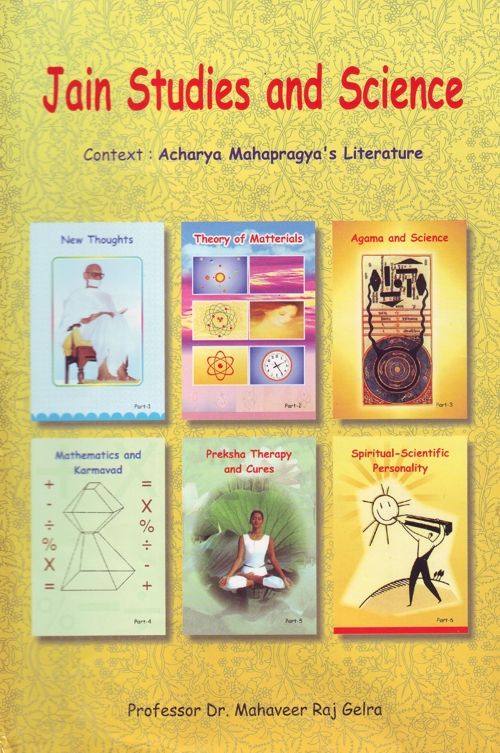Mahapragya has given significance to the effects of Preksha Meditation on the secretions of various glands of the human body. In our earlier discussions, we have already emphasized as to how various emotional aspects are governed by our hormones. We shall now elaborate how the nervous system and endocrine system together control the activities of all the organs and systems of the human body.

The endocrine glands are the organs in which hormones are produced and released into the blood. Hormones act as organic-chemical messengers which exert a powerful influence on the body. However, we have no direct and conscious control over them. These chemicals play a vital part in growth and development besides controlling a wide range of daily activities. There are eight principal endocrine glands-
- Hypothalamus and Pituitary
- Pineal
- Thyroid
- Parathyroid
- Pancreas
- Adrenal
- Thymus
- Gonads (testes or ovaries)
Functional Mechanism- Above mentioned glands are interrelated to each other and form a close loop control. Hypothalamus, in close association with pituitary, controls the entire endocrine system. When hormones from pituitary reach the target organ, the receptors of target organ responds to it and thus the targeted gland either stimulates or inhibits the secretions of its own hormones. The feedback from the target gland is received back by both the pituitary and hypothalamus. The chain continues till the right amount of hormones is available in the blood stream.
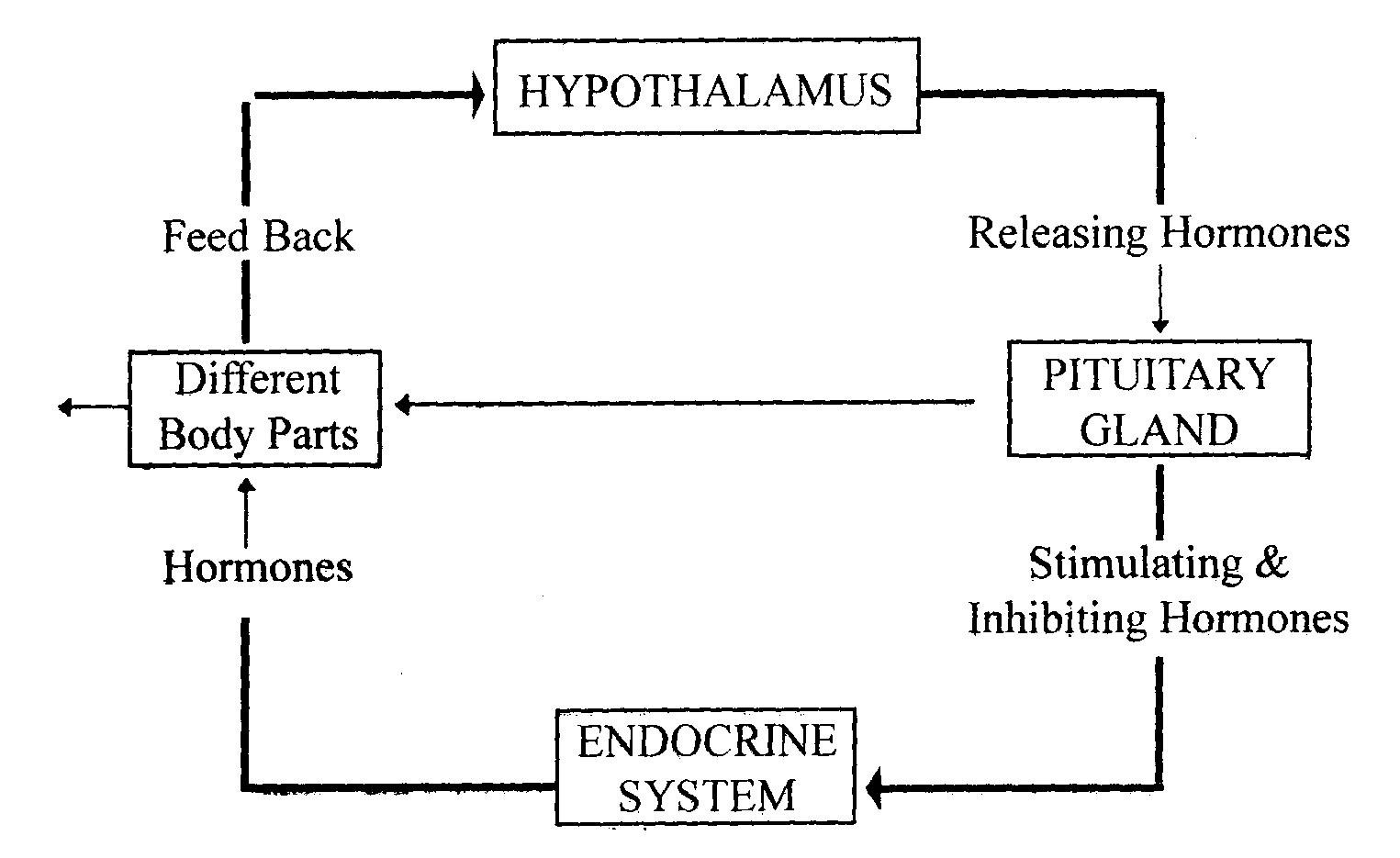
The Pituitary Gland
It is also known as hypophysis or Master Gland. This gland is situated at the base of the skull in a bony hollow. Structurally no larger than a bean, it is suspended from the hypothalamus, to which it is connected by a short stem. Its shape looks divided into two lobes, the anterior and the posterior.
Hormones secreted by front part (anterior lobe) of this gland are -
- Somatotrophin - It stimulates growth and also controls another hormone prolactin which stimulates lactation.
- Thyrotrophic (TSH) - Thyroid Stimulating Hormones. As the name suggests, it affects thyroid.
- Gonadotropin - Follical Stimulating Hormones (FSH) and Luteinizing Hormones (LH) regulate the function of sex organs.
- Adrenocorticotrophin (ACTH) - It controls the production of adrenalin, noradrenalin and steroids in the adrenal gland.
Hormones secreted by rear part (posterior lobe) of this gland are -
- Vasopressin - Also called as Antidiuretic hormone (ADH), controls the salt and water excretion from kidneys.
- Oxytocin - It stimulates uterus to contract during birth and is also involved in secretion of milk.
These wide ranging chemicals of pituitary, makes it the most important of all. It not only controls the physical growth but regulates will power, memory and hearing capacities. An activated state of pituitary is essential for the overall personality development.
The Pineal Gland
The Pineal Gland is about the size of a pea, and is in the centre of the brain in a tiny cave behind and above the pituitary gland which lies a little behind the root of the nose. It is located directly behind the eyes, attached to the third ventricle.
The true function of this mysterious gland has long been contemplated by philosophers and spiritual adepts. Greek philosopher Descartes called it the Seat of the Soul. This gland is activated by Light, and it controls the various biorhythms of the body. It works in harmony with the hypothalamus gland which directs the body's thirst, hunger, sexual desire and the biological clock that determines our aging process. It is presumed to secrete melanotropin hormone.
The Thyroid Gland
It is situated at the base of the neck, front of trachea (wind pipe). Its structure looks like the alphabet 'H' (like a necktie) such that its two lobes are joined together by a bridge of tissues. It produces two main hormones:
- Thyroxin (T4 - tetraiodothyronin)
- Tri'iodothyronin (T3)
Both of these are essential for normal growth of nerve tissues. However, their main function is to control rate of basal metabolism, that is, how the body uses its energy and the consumption of oxygen.
These hormones are produced with the help of iodine. Body gets iodine through food from where it is absorbed by blood and reaches to thyroid. Thyroid stores its hormones in globular sacs called follicals. Around these follicles are parafollicular cells which produce another hormone, calcitonin. This hormone plays important role in calcium absorption by diverting excess calcium to the bones.
Hyper and Hypo thyroidisms, both conditions invite several diseases. An overactive thyroid gland results in thyrotoxicosis whose symptoms are protrusion of eyeballs, nervousness, irritability, sweating and loss of weight. Conversely, if thyroid is under active, it results in Myxoedema. Its main symptoms are tiredness, swollenness, sensitivity to cold and constipation.
An important point to note is that thyroid activities are affected in conditions of fear and anger.
The Parathyroid Gland
There are four parathyroid glands which are normally about the size and shape of a grain of rice situated on the posterior surface of thyroid glands. They produce a chemical, parathormone. This hormone raises the level of calcium in blood. The sole purpose of the parathyroid glands is to regulate the calcium level in our bodies within a very narrow range so that the nervous and muscular systems can function properly. Although they are neighbours and both part of the endocrine system, the thyroid and parathyroid glands are otherwise unrelated. The single major disease of parathyroid glands is over activity of one or more of the parathyroids which make too much parathyroid hormone causing a potentially serious calcium imbalance. This is called hyperparathyroidism.
The Pancreas
As an abdominal gland, it lies behind the stomach, with its head pointed toward the small intestine, and its tail pointed to the right. The pancreas produces chemicals that are crucial to proper digestion and blood sugar regulation. It is a mixed gland having both exocrine and endocrine functions.
Important hormones secreted by the pancreas include:
- Insulin
- Glucagon
These maintain the appropriate levels of sugar throughout our body. The parts of the pancreas responsible for the production of hormones are the Islets of Langerhans, which are small clusters of cells separated from the exocrine functions. When unprocessed sugar needs to be converted into the kind of energy our cells use, it travels to the liver. There, glucagon breaks down the glycogen variety of sugar and releases its components into our blood. Then, insulin appears at the site of cells to help them easily absorb the sugar.
On dual duty, the pancreas also creates digestive juices as a member of the exocrine system. These fluids break down those nutrients which the stomach's acids could not effectively metabolise. Since the pancreas is so close to the small intestine, there are many ducts streaming from its head to carry the enzymes to the duodenum, the beginning of the intestine. The juices start out alkaline in the pancreas, but when they meet substances bathed in stomach acid in the duodenum, they become acidic. These enzymes include amylase, which digests fat, trypsin for protein, and lipase which works on carbohydrates. The resulting nutrients are distributed further down the small intestine. It is because of these dual activities, both the exocrine and endocrine systems lay claim to this organ. Our body's endocrine system regulates hormones and other substances through its direct access to the bloodstream, cells, and organs. The exocrine system works via ducts to digest food in the intestinal tract.
Malfunctions of the pancreas include diabetes, pancreatic cancer, pancreatitis, and cystic fibrosis. Any interference with our insulin or enzyme levels wreaks havoc on our wellbeing, whether it is due to genes or diet. To ensure a healthy pancreas, it is essential to maintain good nutrition.
The Adrenal Glands
The adrenal glands are orange-coloured endocrine glands which are located on the top of both kidneys. The adrenal glands are triangular shaped and measure about one-half inch in height and 3 inches in length. Each gland consists of a medulla (the centre of the gland) which is surrounded by the cortex.
The adrenal cortex produces hormones necessary for fluid and electrolyte (salt) balance in the body. Three important cortex hormones are:
- Cortisone (Glucocorticoids)
- Aldosterone (Mineralocorticoids)
- Androgens and Oestrogens (Testosterone and Progesterone)
The glucocorticoids control metabolism of fats, proteins and carbohydrates. The mineralocorticoids regulate balance of fluids and mineral ions like potassium and sodium. Adrenal sex hormones secrete in very small quantities and only complement the other sex hormones produced by testes or ovaries.
The medulla is responsible for producing adrenaline and noradrenaline hormones. The medulla is actually a part of autonomic nervous system and it prepares the body to utmost alertness in the events of danger and stress. This is achieved by altering the blood flow and releasing the energy from liver.
The Thymus
The thymus is a bi-lobed, greyish organ located in the thoracic cavity just below the neck. Curiously, when the thymus is removed from adult mammals, few effects are seen. However, when the thymus is removed at birth, dramatic effects are witnessed. The thymus develops from the childhood till adulthood. Though the activities and chemicals of this organ are still an enigma, its proper functioning is essential for our immune system.
The Testes & Ovaries
These glands secrete male and female sex hormones.
The testes are two egg shaped male glands suspended in a bag of skin, the scrotum, behind the penis. Their two main activities are-
- To produce spermatozoa essential for reproduction.
- To produce testosterone responsible for enhancing the male characteristics like - hair-growth, body-contours and thick voice.
The ovaries are egg producing organs having an oval shape. Each of them consists of at least 200,000 follicles which are microscopic capsules housing egg cells. Besides being abode to ovum, ovaries produce female hormones oestrogens and progesterone. These hormones develop female specific characteristics as well as regulate the menstrual cycles.
Energy Centres
Based on his studies of traditional Jain literature, ancient Hindu mysticism and also based on his experiments with Preksha meditation, Mahapragya has postulated several energy centre of the body. These are called chakras (wheels of energy) in tantra terminology, core-points in ayurveda and conscience-centres in Preksha meditation. A few are mentioned here for the spiritually enlightened readers.
- Shanti Kendra - Front cerebral part relates to hypothalamus.
- Jyoti Kendra - Centre of forehead. Also called the Third Eye. Field of pineal.
- Darshan Kendra - Slightly below the Jyoti Kendra, it is situated at the centre of eyebrows. Relates to Pituitary gland.
- Vishudha Kendra - Situated in throat area. Relates to thyroid and parathyroid glands.
- Anand Kendra - Below lungs and behind heart, it relates to thymus.
- Shakti Kendra - It is the area of influence of gonads.
- Tejas Kendra - Area of Kundalini. Relates to adrenal gland and kidney.
- Swasthya Kendra - Pancreas being responsible for metabolism of food, controls the entire body health.
- Bhrahma Kendra - The frontal tongue is defined as Bhrahma Kendra.
- Pran Kendra - Nasal tip forms this Kendra. It is of great importance during mediattion.
- Apramad Kendra - Ears form this Kendra which is responsible for alertness.
- Chakshuksh Kendra-Situated above eyes, it is source of life force.
- Gyan Kendra - Relates to the invisible soul and is beyond all senses and organs.
Comparison with Medical Science
Parallels have often been drawn, by supporters of the existence of chakras, between the positions and functions of the chakras, and of the various organs of the endocrine system. A clear correlation is visible in the above list. However, advocates of modern medicine often disregard this theory on the ground that the hormone production and secretion cannot be achieved by concentrating on a particular chakra because it is controlled by the chemical signals sent by the brain based on a self sustained feedback mechanism.
Mahapragya, however, differs with this medical explanation. According to him, these centres of energy keep on working spontaneously by the inbuilt intelligence of the body, but their functions can be enhanced and refined very effectively by the process of Preksha meditation. Mahapragya states that it is not always that the brain is in command. If we concentrate on a particular centre of energy, that centre sends request to the brain for immediate release of necessary chemicals. It is like an account holder getting his cheque remitted by the bank, which bank cannot refuse so long as the balance exists. The name Preksha itself suggests - projecting or directing concentration on something. In case of meditation, this projection of energy is done on body organs to achieve spiritual peace and ecstasy. This process of Preksha meditation helps remove internal conflicts and opens up a untapped resources hidden in our body system.
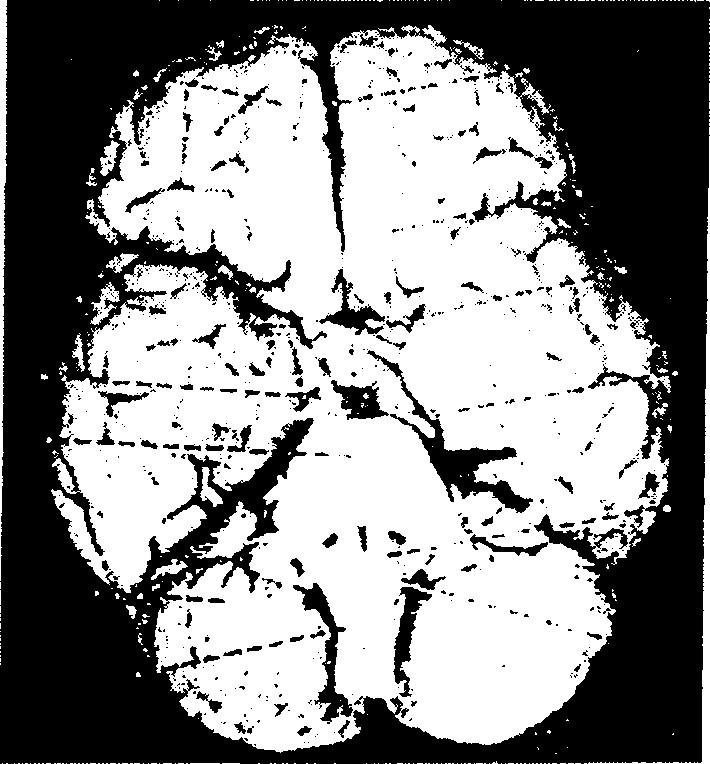
Inferior view of the brain
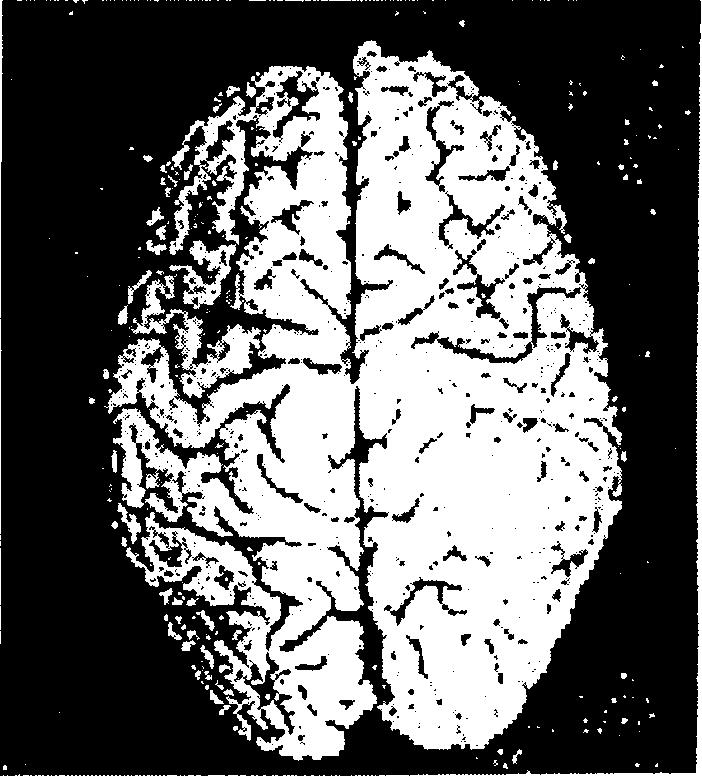
Superior view of the brain
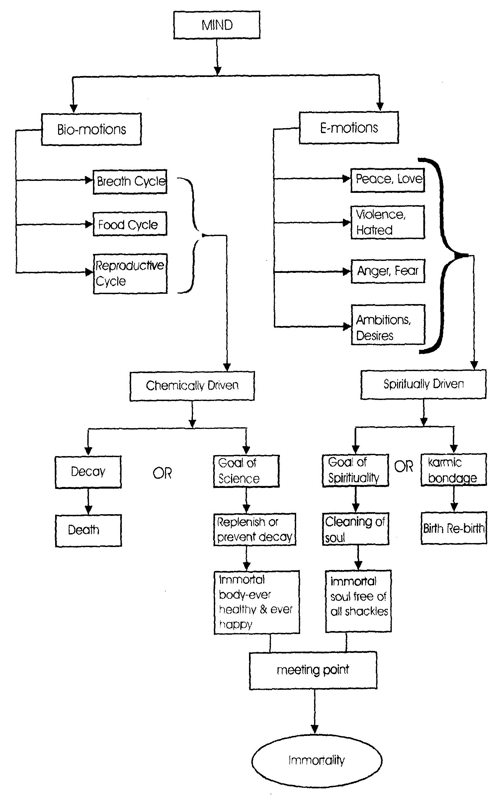
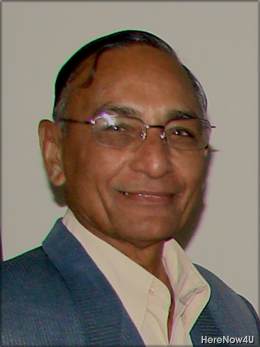 Dr. Mahavir Raj Gelra
Dr. Mahavir Raj Gelra
